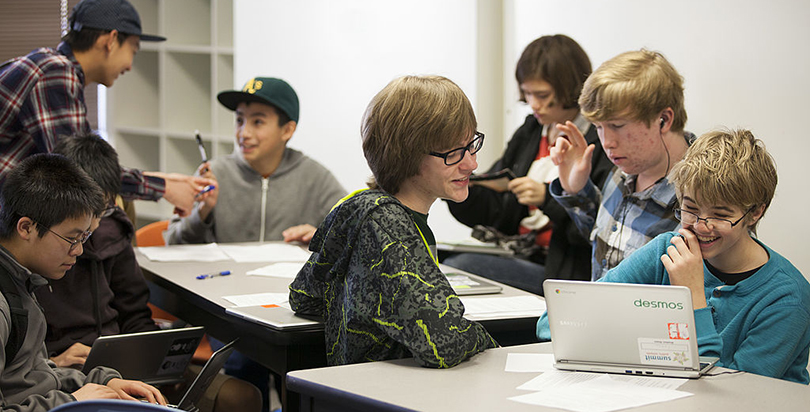Mesecar — Personalized Learning Under the Every Student Succeeds Act: 3 States Now Leading the Way

It is difficult to identify sustained improvements over the past 25 years in student outcomes across the country. During this same period, total federal, state, and local spending on education has exceeded $12 trillion, which is almost 20 percent more than the total spending on transportation and water infrastructure at all levels of government. Has our country’s collective investment in education been more productive than its infrastructure spending?
A commonsense assessment of educational success is whether students are prepared for starting college or a career after high school. Studies show that 1 in 4 first-year college students needs remedial coursework, costing families almost $1.5 billion every year. And it’s not just college — the number of open manufacturing positions hit a 15-year high a little over a year ago because too many students are not prepared for these jobs. Distressingly, nearly 20 percent of 15-to-29-year-olds are not in any form of employment, education, or training.
National and international assessments of student learning show stagnation, such as on the National Assessment of Educational Progress (frequently called the Nation’s Report Card) or the Programme for International Student Assessment.
The federal law — ESSA — provides policymakers with more opportunities to tailor educational spending and policy to their circumstances. But ESSA is about more than just returning control to state and local policymakers. It also has provisions and funding that can be used to further efforts to transform teaching and learning from batch processing to interactive processing, where learning is responding to real-time adjustments, not after-the-fact record-keeping.
If state and district leaders step up, ESSA can inject energy into the growing interest in personalizing the education experience for every learner, combining effective teaching with adaptive technology to scale individualized instruction for every student. In a personalized learning approach, students can learn at their own rates in different subjects. While this may seem obvious, it’s much easier said than done, which is why it is so important to have early adopters paving the way for those that will inevitably follow.
Over the past few years, there have been some impressive gains in student achievement in districts and schools that thoroughly integrate state-of-the-art technology to individualize the learning experience for all students. Districts implementing personalized learning over multiple years show learning gains exceeding 125 percent, which means students are gaining more than one year’s worth of academics in one school year.
A few states are rapidly and systemically shifting to personalized education approaches, like New Hampshire and Rhode Island. Others, like Tennessee, New Jersey, and New Mexico, are seizing the opportunity ESSA provides to start moving to personalized learning. The next round of states should study and build upon these types of strategies and initiatives that are possible under ESSA in their upcoming state plan submissions.
Tennessee has the most comprehensive approach to personalized learning under ESSA of the 17 initial state plans submitted to the U.S. Department of Education. Tennessee has thought deeply about how personalized learning is fundamental to its educational system, writing in its plan, “Through personalized learning opportunities, we will support districts in exploring new approaches to professional learning for teachers, considering student centered learning experiences, and leveraging technology and flexibility in how students learn and demonstrate mastery.” The state is also looking at how it could support competency-based instructional models, where students progress at their own pace as they master content, by learning from local districts piloting these efforts and others outside the state.
New Jersey is proposing to develop training, guidance, and other assistance for how educators can strategically use technology to enhance teaching using real-time, effective feedback and digital personalized learning tools. Using federal funds, the state will provide job-embedded and online training, materials, and tools to districts. To take full advantage of the state’s objectives, districts will need to seize the opportunity, put the state’s support to good use, and learn from their peers, such as New Jersey’s 2017 Superintendent of the Year, Ross Kasun, whose Freehold Township Schools are implementing an ambitious district-wide personalized learning program.
In New Mexico, the state plans to leverage new funding under the law’s Title IV Student Support and Academic Enrichment block grant to train and support principals and other leaders to help teachers in using data and technology to improve instruction and personalize learning. New Mexico is also one of the few states (so far) to propose using ESSA’s Direct Student Services provision, which allows states a unique flexibility to partner with districts to rethink the use of federal Title I funds to provide innovative approaches directly to educators, families, and students. Pursuing personalized learning is identified in the plan as one of the state’s key priorities for districts and schools.
More study is needed on how to best implement personalized learning across multiple different models, though that task is complicated by the evolving nature of these innovative approaches. However, research on cognitive science and student outcomes — some of it dating back to 1984 — and human individuality shows the potential personalized learning has for improving all students’ outcomes.
State and district policy and practice must evolve in the face of increasing pressure to produce results and rapidly developing technological tools and curricular resources. And with the new federal education law, states and districts have the freedom to actively support accelerated growth in personalized learning models. With early adopters showing the way, greater numbers of students will have a much greater chance of success in school — and in life.
Doug Mesecar is an adjunct scholar at the Lexington Institute. He previously served as a senior official at the U.S. Department of Education and in Congress.
Get stories like these delivered straight to your inbox. Sign up for The 74 Newsletter

;)